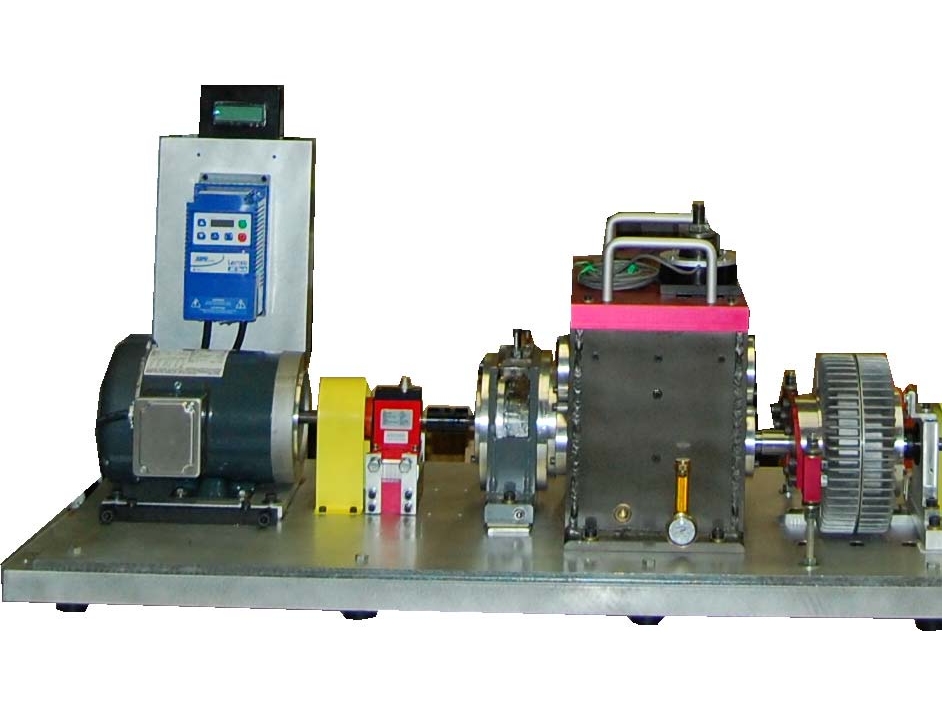The DDS Provides a basic setup for performing drivetrain experiments and for learning vibration signatures of gearbox and bearing malfunctions.However a detailed investigation of particular and more advance vibration phenomena will require additional attachments and fixtures which are available through optional kits.
|
Bearing Fault Kit (G-BFK-1) |
- Learn waveform and spectra of classic bearing defects.
- Learn about signal processing issues such as averaging techniques, leakage, and spectral resolution on determining bearing faults.
- Perform experiments with increasing severity of defects.
- Determine why an ultra-high resolution spectrum is needed to diagnose a bearing fault when fault frequencies are located close to multiples rotational speed.
- Learn how a large signal can mask adjoining low amplitude signal due to spectra leakage.
- The kit consists of one inner race defect, one outer race defect, one with ball defect, and one combination of defects.
| 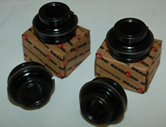 |
Planetary Gearbox Bearing Fault Kit (G-BFK-P) |
- Study bearing faults in planetary gearbox
- The kit consists of two different levels of inner race fault and two different levels of needle fault
| |
Gearbox Sleeve Bearing (G-SBH) |
- Compare vibration signature between rolling element and sleeve bearings.
- Investigate waveform and spectral recognition of worn or loose fitting bearings.
- The kit consists of six 1″ oil-impregnated bronze sleeve bearings
| |
Radial Bearing Loader (G-RBL) |
- Investigate bearing radial loading effects.
- Understand bearing failure signature as a function of load and rotational speed.
- Compare vibration signature between loaded and unloaded bearings.
- Study outer race bearing fault signature as a function of load location.
- The kit consists of one mechanical bearing loader
| |
Defective spur gears (G-SDG) |
- Study the effect of damaged tooth in gearboxes.
- Apply phase demodulation signal analysis to detect gear damage.
- Investigate backlash between mating gears.
- The kit consists of one missing tooth gear, one chipped tooth gear, one root crack gear, and one surface wear gear
| 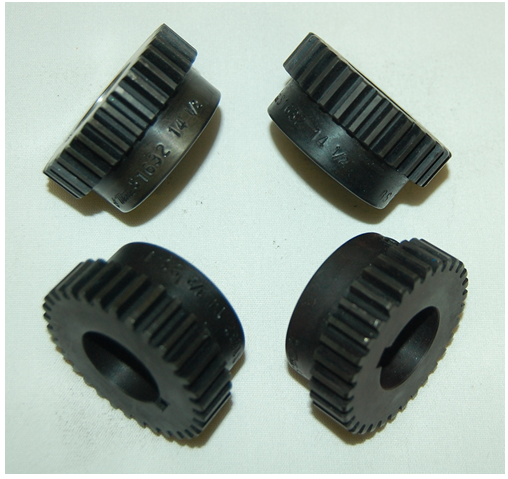 |
Defective planetary gears (G-PDG) |
- Study the effect of damaged planetary gears.
- Apply phase demodulation signal analysis to detect gear damage.
- The kit consists of one missing tooth gear, one chipped tooth gear, one root crack gear, and one surface wear gear
| |
Eccentric Spur Gear (G-ESG) |
- Study the effects of eccentric spur gear.
- Measure the vibration signature of eccentric gears.
- The kit consists of one eccentric spur gear.
| 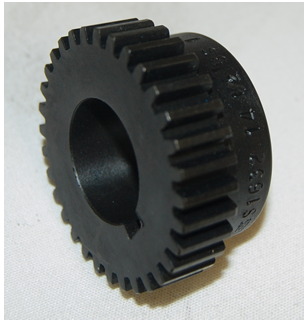 |
Helical gears set (G-HG) |
- Study the helical gears parallel shaft gearbox.
- Compare vibration signature between spur and helical gears.
- The kit consists of four helical gears to replace standard spur gears in gearbox
| 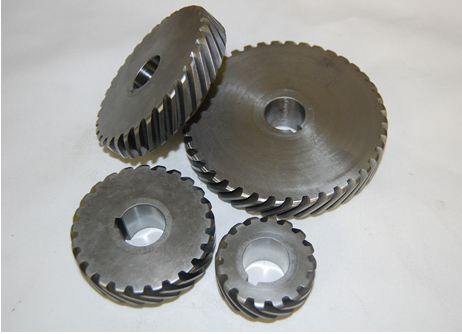 |
Defective helical gears (G-HDG) |
- Study the effect of damaged helical gears.
- Apply phase demodulation signal analysis to detect gear damage.
- The kit consists of one gear with chipped tooth and one gear with missing tooth,and one gear with surface defect
- Requires G-HG
| 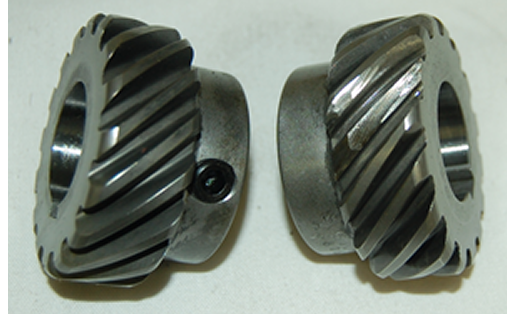 |
Torque transducer with built encoder on input shaft (G-TOR) |
- Measure the torque on the input shaft.
- Study torque variation through full rotation cycle.
- Track shaft position in signal analysis.
- The kit consists of one 20 N.m torque meter with built-in 360 pulse encoder
|  |
Shaft encoder (G-ENC) |
- Measure transmission error in the gearbox by comparing input and output rotation.
- The kit consists of one 360 pulse per revolution encoder and once per revolution index
|  |
PC Motor Control Kit (G-PCK) |
- Operate DDS from remote location.
- Pre-program speed acceleration, deceleration, and length of run to meet exact requirements.
- The kit consists of PC software, one interface module to motor drive and cables.
| 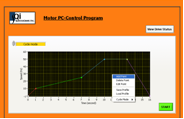 |
PC Load Control Kit (G-PCLK) |
- Operate magnetic brake from remote location.
- Pre-program load profiles of run to meet exact requirements.
- The kit consists of PC software, one interface module to magnetic brake and cables.
| |
Radial Bearing Loader Force Transducer (G-RBFT) |
- Measure the radial load applied by the mechanically operated bearing loader.
- The kit consists of one transducer measuring radial force and one matching signal conditioner.
| |
3 HP AC Motor With Built-In Rotor Unbalance (G-UBM-3) |
- Study the effects of unbalanced rotor on vibration and/or current signature.
- Study the effect of unbalance rotor on power quality and consumption.
- Study the effect of temperature rise on non-linear characteristics of induction motors.
- The kit consists of one unbalanced 3 HP AC motor
| |
3 HP AC Motor With Built-In Rotor Misalignment System (G-MAM-3) |
- Study the effect of variable air gap on vibration and/or current signature.
- Study the effect of amount/type of misalignment and rotor speed on vibration/current spectra.
- Determine the effect of misalignment on power quality and consumption.
- Study the effect of temperature rise on non-linear characteristics of induction motors.
- The kit consists of one 3 HP AC motor with custom machined end bells, which allows for easy introduction of known misalignment at either end of the motor.
| |
3 HP AC Motor With Built-In Bowed Rotor (G-BRM-3) |
- Study the effects of rotor bow on vibration and/or current signature.
- Study the effect of bowed rotor on power quality and consumption.
- The kit consists of one 3 HP AC motor with centrally bent rotor
| |
3 HP AC Motor With Built-In Faulted Bearings (G-FBM-3) |
- Study the effects of bearing faults on vibration and/or current signature.
- Study the effect of bearing faults on power quality and consumption.
- The kit consists of one 3 HP AC motor fitted with one inner race faulted bearing and one with outer race faulted bearing. User can specify the types of bearing faults.
| |
3 HP AC Motor With Built-In Broken Rotor Bars (G-BRBM-3) |
- Study the effect of broken rotor bars on motor vibration and/or current signature as a function of speed and load.
- Study the effect of broken rotor bars on power quality and consumption.
- Study the effect of temperature rise on non-linear characteristics of induction motors.
- The kit consists of one 3 HP AC motor with broken rotor bars
| |
3 HP AC Motor With Stator Winding Faults (G-SSTM-3) |
- Study the effects of turn-to-turn short in stator windings on vibration and/or current signature.
- Study the effect of turn-to-turn short in stator windings on power quality and consumption.
- Study the effect of temperature rise on non-linear characteristics of induction motors.
- The kit consists of one 3 HP AC motor with shorted stator winding turns, and one control box to vary short conditions.
| |
3 HP AC Motor With Voltage Unbalance & Single Phasing (G-VUSM-3) |
- Study the effects of voltage unbalance and one phase loss on motor current/vibration signatures.
- Study the effect of voltage unbalance and one phase loss on power quality and consumption.
- Study the effect of temperature rise on non-linear characteristics of induction motors
- The kit consists of one 3 HP AC motor and one control box to vary voltage balance and to disconnect one phase.
| |
